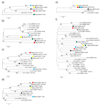Comprehensive characterization of MHC class II haplotypes in Mauritian cynomolgus macaques
- PMID: 17384942
- PMCID: PMC2836927
- DOI: 10.1007/s00251-007-0209-7
Comprehensive characterization of MHC class II haplotypes in Mauritian cynomolgus macaques
Abstract
There are currently no nonhuman primate models with fully defined major histocompatibility complex (MHC) class II genetics. We recently showed that six common MHC haplotypes account for essentially all MHC diversity in cynomolgus macaques (Macaca fascicularis) from the island of Mauritius. In this study, we employ complementary DNA cloning and sequencing to comprehensively characterize full length MHC class II alleles expressed at the Mafa-DPA, -DPB, -DQA, -DQB, -DRA, and -DRB loci on the six common haplotypes. We describe 34 full-length MHC class II alleles, 12 of which are completely novel. Polymorphism was evident at all six loci including DPA, a locus thought to be monomorphic in rhesus macaques. Similar to other Old World monkeys, Mauritian cynomolgus macaques (MCM) share MHC class II allelic lineages with humans at the DQ and DR loci, but not at the DP loci. Additionally, we identified extensive sharing of MHC class II alleles between MCM and other nonhuman primates. The characterization of these full-length-expressed MHC class II alleles will enable researchers to generate MHC class II transferent cell lines, tetramers, and other molecular reagents that can be used to explore CD4+ T lymphocyte responses in MCM.
Figures





References
-
- Allen TM, Mothe BR, Sidney J, Jing P, Dzuris JL, Liebl ME, Vogel TU, O'Connor DH, Wang X, Wussow MC, Thomson JA, Altman JD, Watkins DI, Sette A. CD8(+) lymphocytes from simian immunodeficiency virus-infected rhesus macaques recognize 14 different epitopes bound by the major histocompatibility complex class I molecule mamu-A*01: implications for vaccine design and testing. J Virol. 2001;75:738–749. - PMC - PubMed
-
- Allen TM, Sidney J, del Guercio MF, Glickman RL, Lensmeyer GL, Wiebe DA, DeMars R, Pauza CD, Johnson RP, Sette A, Watkins DI. Characterization of the peptide binding motif of a rhesus MHC class I molecule (Mamu-A*01) that binds an immunodominant CTL epitope from simian immunodeficiency virus. J Immunol. 1998;160:6062–6071. - PubMed
-
- Allen TM, Vogel TU, Fuller DH, Mothe BR, Steffen S, Boyson JE, Shipley T, Fuller J, Hanke T, Sette A, Altman JD, Moss B, McMichael AJ, Watkins DI. Induction of AIDS virus-specific CTL activity in fresh, unstimulated peripheral blood lymphocytes from rhesus macaques vaccinated with a DNA prime/modified vaccinia virus Ankara boost regimen. J Immunol. 2000;164:4968–4978. - PubMed
-
- Altman JD, Moss PA, Goulder PJ, Barouch DH, McHeyzer-Williams MG, Bell JI, McMichael AJ, Davis MM. Phenotypic analysis of antigen-specific T lymphocytes. Science. 1996;274:94–96. - PubMed
-
- Auffray C, Lillie JW, Arnot D, Grossberger D, Kappes D, Strominger JL. Isotypic and allotypic variation of human class II histocompatibility antigen alpha-chain genes. Nature. 1984;308:327–333. - PubMed
Publication types
MeSH terms
Grants and funding
LinkOut - more resources
Full Text Sources
Other Literature Sources
Research Materials

